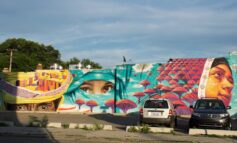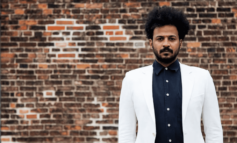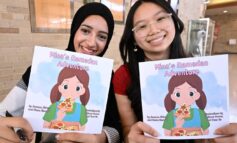There are thousands upon thousands of technically skilled artists and painters, but in the world of fine art, it’s the artist’s individual touch that separates him or her from the rest of the pack.

|
| Ali Hassoun |
The Lebanese-born Hassoun was the first Muslim painter to be chosen to paint the banner for the race and accompanying festival, both of which are heavily steeped in Christian traditions and dedicated to the Virgin Mary.
But controversy broke out in the area from conservative Christians when Hassoun’s version of the banner was unveiled to reveal its placement of Islamic imagery and words.
Hassoun’s version of the banner, which is 250 centimeters in height and 80 centimeters in length, followed the tradition of painting the Virgin Mary on the top of the Palio, but he added the unique touch of including the title of the 19th chapter of the Qur’an above her, as the chapter is dedicated to her. On her crown in the painting are the symbols of the three Abrahamic religions: the crescent symbolizing Islam on the left, the Christian cross in the middle, and the Star of David representing Judaism on the right.
Mary’s face was also inspired by Hassoun’s Christian wife of Italian descent. Saint George, another traditionally painted figure, is seen wearing a kaffiyeh in Hassoun’s version of the Palio as well. On the bottom of the banner are the symbols of the various contradas, or districts, that competed in the race.
Hassoun, age 46, who has lived in Italy since 1982, said that his version of the Palio banner was meant to promote commonality and understanding among the three prominent religions.
“My way of thinking and my way of making art indeed gave me the vision to do the Palio this way,” Hassoun said in a phone interview. “I believe we of the different religions have the same humanity and believe in the same God.”
Hassoun believes that this is an important time in human history as tensions between the three religions continue to fester and misunderstanding of many religions, particularly Islam, has continued to create rifts.
Controversies over mosque projects in the country have popped up in recent years, especially in the north according to Hassoun, which he says is less progressive.
But Hassoun believes that art is one way to bridge the gap of cultural understanding.
“I think that artists see things before they happen, they see history for us. It’s a way for people to learn more about their vision of humanity and I think that this moment in our history is so important to do some new path to be nearer and closer to each other.”
Hassoun said he took the controversy surrounding the Palio, which was blessed in the Church of St. Mary of Provenzano prior to the race according to tradition, in stride.
“I think it’s good that the painting made this controversy because people need some signs to speak to each other, and now we saw bad signs of not accepting so now artists are giving me the possibility to talk to them and tell something new,” he said.
Hassoun is hopeful that the Palio controversy is one step toward a more enlightened future in regards to the discussion about Islam in Italy and other issues.
“This is the first time in the very important city of Siena and Italian history that they called an artist like me, a Muslim artist, and accepted my way of thinking,” he said.
“It gave me a sign of civilization that this controversy is going to help in some way to make new levels of conscience among the people.”





Leave a Reply